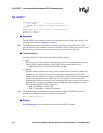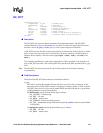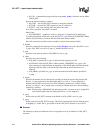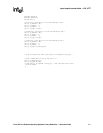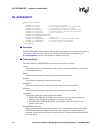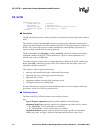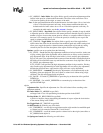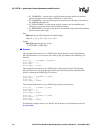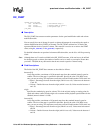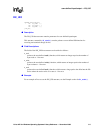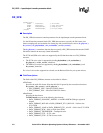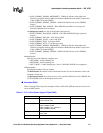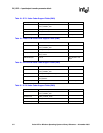
Voice API for Windows Operating Systems Library Reference — November 2003 515
speed and volume adjustment condition block — DX_SVCB
• SV_ABSPOS – Index Mode: Sets adjsize field to specify an absolute adjustment position
(index) in the speed or volume modification table. The index value can be from -10 to
+10, based on position 0, the origin, or center, of the table.
Note: In the speed modification table, the default entries for index values -10 to -6 and +6 to
+10 are -128 which represent a null-entry. In the volume modification table, the
default entries for index values +6 to +10 are -128 which represent a null-entry. To
customize the table entries, use the dx_setsvmt( ) function.
• SV_RELCURPOS – Step Mode: Sets adjsize field to specify a number of steps by which
to adjust the speed or volume relative to the current position in the table. Specify a positive
number of steps to increase the current speed or volume, or a negative number of steps to
decrease it. For example, specify -2 to lower the speed (or volume) by two steps in the
speed (or volume) modification table.
• SV_TOGGLE – Toggle Mode: Sets adjsize field to specify one of the toggle defines,
which control the values for the current and last-modified speed and volume settings and
allow you to toggle the speed or volume between standard (the origin) and any setting
selected by the user. See the description of the adjsize field for the toggle defines.
Options: specifies one or no options from the following:
• SV_LEVEL – Level: Sets the digit adjustment condition to be level-sensitive. At the start
of play, existing digits in the digit buffer will be checked to see if they are level-sensitive
play adjustment digits. If the first digit in the buffer is a level-sensitive play adjustment
digit, it will cause a play adjustment and be removed from the buffer. Subsequent digits in
the buffer will be treated the same way until the first occurrence of any digit that is not an
SV_LEVEL play adjustment digit.
If SV_LEVEL is not specified, the digit adjustment condition is edge-sensitive. Existing
edge-sensitive play adjustment digits in the digit buffer will not cause a play adjustment;
but after the playback starts, edge-sensitive digits will cause a play adjustment.
• SV_BEGINPLAY – Automatic: Sets the play adjustment to occur automatically at the
beginning of the next playback. This sets a speed or volume level without using a digit
condition. The digit and digtype fields are ignored.
• SV_PAUSE – Use with SV_SPEEDTBL to pause the play on detection of the specified
DTMF digit.
• SV_RESUME – Use with SV_SPEEDTBL to resume the play on detection of the
specified DTMF digit.
adjsize
Adjustment Size: Specifies the adjustment size. The valid values follow according to the
adjustment method:
For Index Mode (SV_ABSPOS in type field)
an integer from -10 to +10 representing an absolute position in the SVMT
For Step Mode (SV_RELCURPOS in type field)
a positive or negative integer representing the number of steps to adjust the level relative
to the current setting in the SVMT
For Toggle Mode (SV_TOGGLE in type field)
On DM3 boards, the following are valid values:
• SV_TOGORIGIN – sets the digit to toggle between the origin and the last modified speed
or volume level (for example, between the -5 and 0 levels)
• SV_CURORIGIN – resets the current speed or volume level to the origin (same effect as
SV_ABSPOS with adjsize 0)
On Springware boards, the following are valid values:




